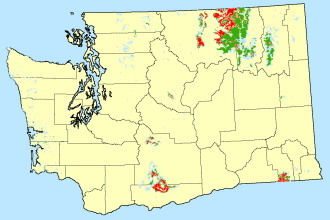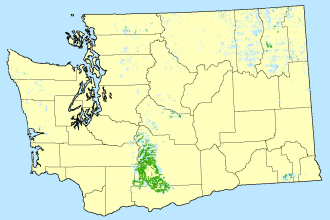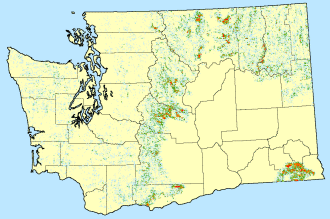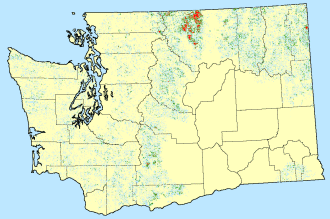Forest Insect and Disease Highlights
in Washington, 2001
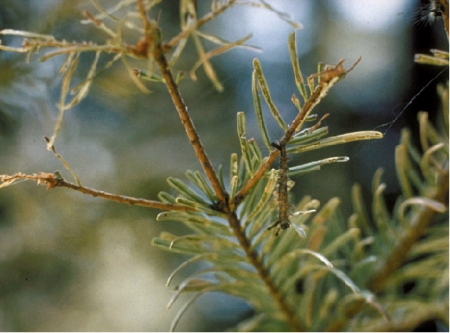


Contributors:
| Keith Sprengel1 | Dan Omdal2 | |
| Julie Johnson1 | Karen Ripley2 | |
| Jeff Moore2 | Kathy Sheehan1 | |
| 1 U.S. Department of Agriculture, Forest Service 2 Washington Department of Natural Resources |
||
June 2002
go to a more printable PDF version (1.1
MB) of this document
Introduction
Insects and disease pathogens cause significant tree mortality, growth loss, and damage to large volumes of potential wood products each year. They reduce management options for landowners and contribute to hazardous forest fire conditions. However, these disturbance agents are a natural and necessary part of forest ecosystems. They support ecological processes such as decomposition and nutrient cycling. They create openings, enhance tree species diversity, and provide food and habitat that many animals depend on. A healthy forest is not free of insects, diseases, disturbances, and tree defects.
This report serves to inform readers about major insect and disease activity levels in Washington in 2001. For additional information to locate or identify specific damage or to obtain information on management techniques to reduce impacts from Forest Health Protection, contact the Washington Department of Natural Resources' Forest Health Program (see contacts).
Climate
The winter of 2000-01 was the driest on record in Washington since 1977 (see chart). November to February precipitation was generally 50-60% of normal. Typically, a dry winter has little direct affect on tree health since the tree is dormant during this time. However, a drought this extreme, even when tempered by near normal precipitation in the spring and summer, may deplete available moisture and contribute to tree stress.
Drought stress makes trees more susceptible to insect and disease pathogens. Once these trees succumb, they become reservoirs for root disease and/or bark beetle populations, which in turn may attack other trees nearby.
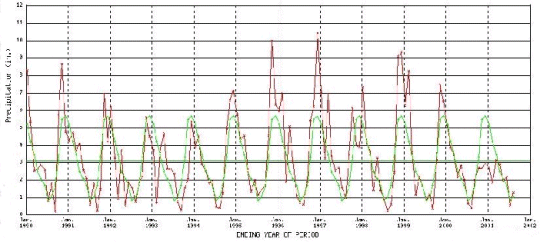
Average (green line) and actual (red line) monthly precipitation observations for the State of Washington as reported by the Western Regional Climate Center, 1990-2001.
Aerial Survey
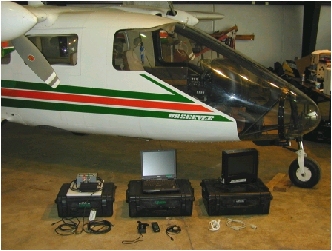
Specialized plane plus digital mapping equipment used during aerial surveys; photo by Keith Sprengel, USDA Forest Service
Washington and USDA Forest Service cooperators have conducted an aerial sketchmapping program for more than fifty years. Prior to the 2001 season, the methodology had changed very little. Observers looked out the aircraft window and recorded the location of damage on a paper map.
In 2001, we implemented a digitally assisted sketchmapping system. Observers now record damage locations on a touch-sensitive computer screen displaying the airplane's current position on user-defined electronic background maps. This system utilizes real-time global positioning and eliminates problems associated with observer disorientation. Although it speeds up data processing, the new system can be challenging when mapping large, landscape scale events. Planned improvements and increased experience should help compensate for this shortcoming in the future.
For more information about our aerial survey program, please visit: www.fs.fed.us/r6/nr/fid/health.shtml. This site is updated annually with the latest information on exotic pest problems, insect and disease outbreaks, and Oregon and Washington forest health trends. Color photos of pests and their resulting damage are included.
Aerial Survey data is available from this Forest Service Pacific Northwest Region website: www.fs.fed.us/r6/nr/fid/data.shtml.
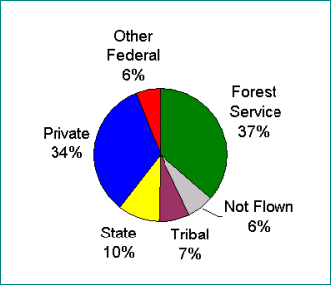
Left: Forested acres in Washington surveyed by
air in 2001, by land ownership category
Insects
Bark Beetles
Mountain and Western Pine Beetle
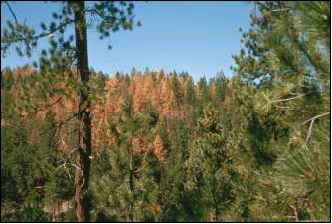
Trees killed by mountain pine beetle;
photo by W.C. Guy, USDA Forest Service.
Pine bark beetle populations continued at epidemic levels with over 151,100 acres affected statewide, an increase from 67,300 acres in 2000. Mountain pine beetle activity increased along the east slopes of the North Cascades in association with overstocked stands of mature lodgepole pine. High elevation east slopes of the Cascades where whitebark pine has been weakened by white pine blister rust showed increased mountain pine beetle activity. Bark beetle-caused damage to ponderosa pine in the Spokane area has decreased.
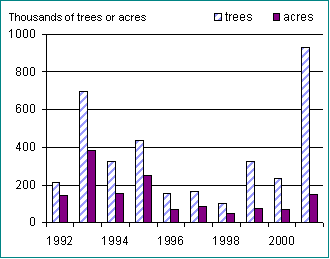
Number of trees killed by and acres infested with mountain
pine beetle
or western pine beetle as detected during annual aerial surveys
Douglas-fir Beetle
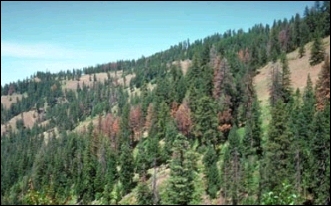
Trees killed by Douglas-fir beetle; Dave Powell (USDA Forest Service) photo from www.forestryimages.org
Douglas-fir beetle activity has increased, affecting over 120,000 acres, up from 70,600 acres in 2000. Over-stocking, high stand age, disease, prolonged droughts, and mild winters continue to stress trees, making them susceptible to bark beetles. Activity increased primarily in the southeast Cascades where defoliation by western spruce budworm has weakened trees. Douglas-fir beetle activity may go undetected where trees have been severely defoliated, because when the trees die there are few needles left to change color and be apparent to aerial observers.
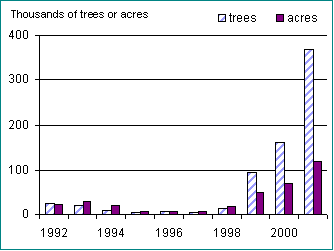
Number of trees killed by and acres infested with Douglas-fir beetle as detected during aerial surveys
Although lower than 2000 levels, Douglas-fir beetle continues to kill large numbers of mature trees in Spokane, Pend Oreille, and Stevens counties. Beetle populations have been at outbreak numbers in that area since the ice storms of 1996-97 caused significant tree damage, providing large amounts of breeding material for the beetles.
Western Balsam Bark Beetle
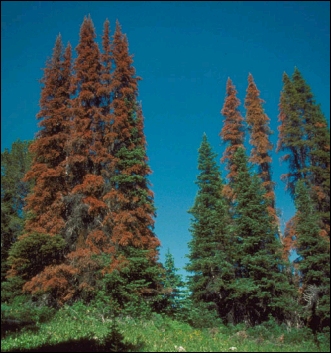
Significant amounts of mortality in subalpine fir were observed in 2001 especially along the eastern slopes of the Cascades. As these trees mature, they become more susceptible to general decline from root disease, competition, drought, and balsam woolly adelgid, making successful attacks by Western balsam bark beetle much more likely.
Activity was recorded on 24,300 acres this year, which is a significant increase from the 3,300 acres mapped a year ago.
Trees killed by western balsam bark beetle; Scott Tunnock (USDA Forest Service) photo provided by www.forestryimages.org
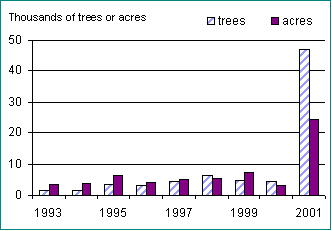
Trees killed by and acres infested with western balsam bark beetle as detected during annual aerial surveys
Defoliators
A wide variety of defoliators affected Washington's forests in 2001. These insects remove leaves and needles, reducing a tree's capacity to convert sunlight into sugars and requiring energy for foliage replacement. Trees suffering from drought stress are generally more susceptible to insect and disease problems, and require longer time to recover from defoliation.
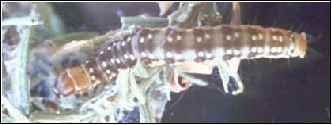
Full-grown western spruce budworm larva; David McComb (USDA Forest Service) photo provided by www.forestryimages.org
Western Spruce Budworm
Most western spruce budworm defoliation map-ped in Washington over the last several years has been in the vicinity of Mt. Adams. In 2001, the outbreak spread to the west and north, reaching Mt. Rainier National Park.
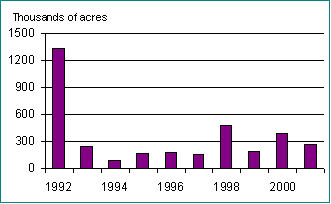
Acres defoliated by western spruce budworm in Washington as detected during aerial surveys; 1998 may be overestimated due to inexperienced observers.
While the total budworm acreage reported in 2001 is down from last year, it is likely that the amount of defoliation this season is at least equal to 2000 levels. Many more areas of light defoliation were not mapped because of difficulty detecting lightly defoliated trees from the air in smoky conditions.
Note: 1998 may be an overestimate (especially in the light category 1&2) because inexperienced observers were surveying the area for the first time.
Douglas-fir Tussock Moth
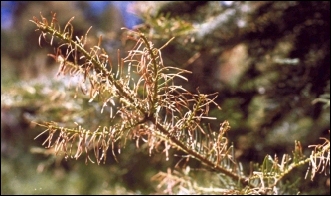
Defoliation by Douglas-fir tussock moth; David McComb (USDA Forest Service) photo provided by www.forestryimages.org.
Douglas-fir tussock moth populations periodically increase to levels sufficient to cause extensive defoliation and tree damage. Populations have been increasing in Washington for several years. To reduce damage in high-value areas, in 2000 the USDA Forest Service applied TM Biocontrol, a naturally occurring virus that only affects tussock moths, to 39,392 acres in the Blue Mountains. Of those treated acres, about 3,900 were sprayed in Washington; the majority was in Oregon. For more information, consult: www.fs.fed.us/r6/nr/fid/dftmweb/
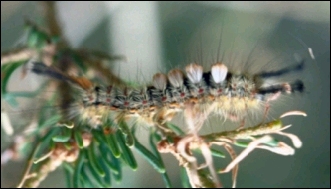
Defoliation by Douglas-fir tussock moth; A. Steven Munson (USDA Forest Service) photo provided by www.forestryimages.org
Larval sampling in the Blue Mountains in 2001 showed low populations at Field Springs State Park. Severe outbreak populations were observed at one private property nearby. About 25 acres of private land there were treated with carbaryl in mid-July, 2001.
Also in 2001, approximately 16,206 acres of federal land and an additional 3,000 acres of state and private lands were treated with TM Biocontrol in the Methow Valley (Okanogan County). The natural virus and added virus are likely to cause the population in the area to collapse in 2002. Very little damage was detectable from the air in that area in the 2001 survey.
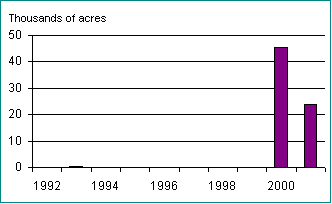
Acres infested with Douglas-fir tussock moth, as detected during annual aerial surveys
About 23,700 acres were defoliated by DFTM in Washington in 2001, down from 45,600 acres in 2000. Most defoliation occurred in the Blue Mountains and on Tekoa Mountain, located on the Spokane and Whitman County borders near Idaho. While the outbreak in the Blue Mountains is declining, high populations are predicted to persist in parts of Tekoa Mountain in 2002. Egg masses were collected in the fall of 2001 for evaluation of virus and parasite levels over the winter. If virus and parasite levels are high, the outbreak would be expected to collapse in 2002. Some areas may require suppression in 2002.
Idaho has been experiencing extreme and widespread defoliation near the Washington border between Plummer and Moscow, as well.
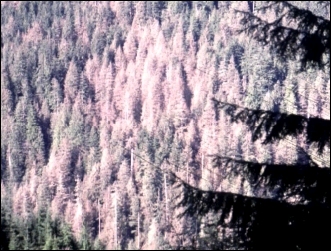
Defoliation caused by hemlock looper and phantom hemlock looper; photo by Washington Department of Natural Resources
Hemlock Looper
Hemlock looper and phantom hemlock looper defoliated approximately 17,300 acres in Washington in 2001, up from 500 acres in 2000. Almost 9,000 acres had high damage levels, mostly on federal lands in the North Cascades. Defoliation of understory trees was extremely heavy.
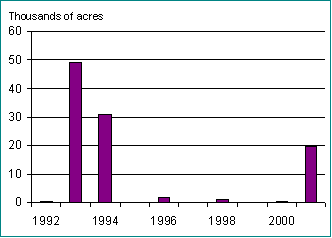
Acres infested with hemlock looper or phantom hemlock looper as detected during annual aerial surveys
Significant hemlock looper/phantom hemlock looper damage was observed near Granite Falls and the City of Everett watershed (Snohomish County). Although hemlock looper is best known as a defoliator of older, multi-layered western hemlock forests, most of this recent defoliation has occurred in second-growth hemlock stands, uniformly 55-60 years of age and with very little understory. Stands thinned within the last 8 years may have had less damage than unthinned stands.
Hemlock looper outbreaks usually last approximately 3 years, but outbreaks from as little as one to as many as six years have occurred. The phase of this outbreak will be assessed during the 2001/2002 winter by collecting and evaluating eggs for evidence of egg parasitism. The impact of defoliation on second growth hemlock stands may be monitored.
Other Defoliators
Pine sawfly defoliated thousands of acres of lodgepole pine in the North Cascades near Ross Lake.
Sawfly also defoliated thousands of acres of noble fir near Grass Mountain (Enumclaw, King County). The boughs were rendered un-sale-able for holiday greens.
Painted lady butterflies were at high populations in 2001 and caused noticeable defoliation on thistle in several parts of the state.
California tortoiseshell completely defoliated several hundred acres of Ceanothus north of Glenwood.
Tent caterpillars were abundant in central Puget Sound (South Whidbey Island, Kingston, Vashon Island) in spring 2001. Alder was their main host.
An outbreak of western oak looper, a species very similar to western hemlock looper, continues in the San Juan Islands. A variety of trees and understory plants are affected. The main host, white oak, is expected to survive the defoliation without damage. Interspersed conifers may be more heavily impacted.
Introduced Insects
Gypsy Moth
Thirty-three gypsy moths were captured in pheromone-baited traps monitored by the Washington State Department of Agriculture in 2001. None were Asian gypsy moths and most were single-catches which will be monitored. A ground-based eradication effort is proposed for approximately 17 acres in north Seattle (Crown Hill) in 2002. An aerial eradication treatment of approximately 560 acres is proposed for an area near Vader (Lewis County) in 2002. A small (29 acre) ground-based treatment in Vader in 2001 did not successfully eradicate that population.
Citrus Long-horned Beetle
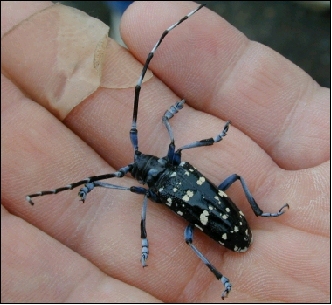
Adult citrus long-horned beetle; photo by Washington Department of Natural Resources
This potentially highly destructive beetle was discovered in both Tukwila and Lacey this year. Both sightings were on recently imported maple bonsai tree nursery stock from Korea. At least five individual beetles are believed to have escaped from the Tukwila site and that area is now quarantined.
This beetle is a close relative of the Asian long-horned beetle and is potentially just as destructive. Many species of hardwoods are potential hosts including oak, poplar, alder, willow, fruit trees, and maple.
For more information about citrus long-horned beetle and gypsy moth in Washington visit: http://www.wa.gov/agr/
Balsam Woolly Adelgid
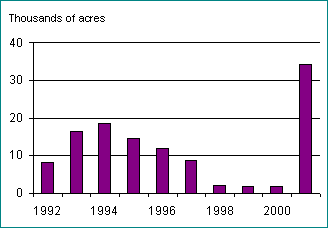
Acres infested with balsam woolly adelgid as detected during annual aerial surveys
The balsam woolly adelgid (BWA) has had significant impacts on grand fir, silver fir and subalpine fir in Washington. It can kill trees slowly by infesting the twigs or branches, or quickly by infesting the bole. BWA also causes gouting of branch nodes. During the 1950's and 1960's it caused extensive mortality primarily along the Cascade Range. Since then, BWA damage has been chronic and subtle, and is not often visible from the air.
Balsam woolly adelgid activity was observed on 34,100 acres in 2001, a significant increase compared to 1,900 acres reported in 2000. Favorable environmental conditions during the winter and spring of 2001 supported increased levels of activity.
Reporting areas with significant acreage of mapped damage include: Gifford-Pinchot in the vicinity of Mt. Adams, Mt. Baker-Snoqualmie, Okanogan, Umatilla, Wenatchee, Yakama Indian Reservation, Mt. Rainier and Olympic National Parks.
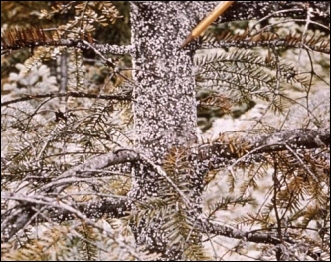
Tree stem infested by balsam woolly adelgid; Wayne Brewer (Auburn University) photo provided by www.forestryimages.org
State-wide, the vast majority of reported, visible activity occurred in subalpine fir stands of federally owned lands.
In 1998, a Forest Health Monitoring ground survey was initiated to confirm the occurrence and distribution of BWA throughout WA and OR, and to determine its effects on host species and changes in local ecosystems. A set of permanent plots indicate that environment plays a significant role in the fluctuations of BWA populations; and that BWA can result in significant ecological impacts on some sites over time by eliminating host species.
The BWA survey has been completed in Oregon. Additional surveys in Washington are planned for 2002.
Animal and Abiotic Agents
Bear Damage
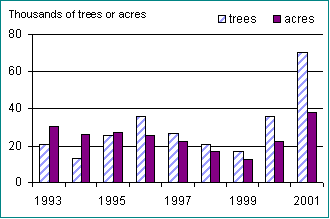
Number of trees killed and acres affected by bears, as detected during annual aerial surveys
A sharp increase in bear damage was seen this year, most noticeably around Forks and in young plantations in the Morton area. This latter could be of special concern since trees in the entire Mt. St. Helens area are just now entering the prime size/age class for bear damage susceptibility.
Over 38,100 acres of bear damage was recorded in 2001 compared to 22,300 acres in 2000.
Unknown
This newly adopted code is used when something unusual is noted but cannot be specifically named. A severity code (High, Medium, Low) or mortality count is associated with it. Several polygons were recorded as being unknown this year, and efforts have been made to ground check these sites for positive identification. Due to limited personnel and difficult access, we are usually unable to clarify the identification of these unknown agents. If anyone is able to obtain additional information, please contact us (see contacts) so that we can improve our reporting.
Diseases
White Pine Blister Rust
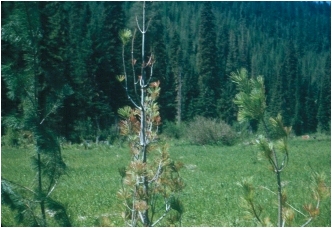
Center tree is affected by white pine blister rust; USDA Forest Service photo
White pine blister rust was recorded on almost 7,700 acres compared to 2,700 acres last year.
This exotic disease infects five needle pines such as western white pine and whitebark pine. This disease makes a slow, chronic progression and, in several areas, has weakened whitebark pine to the point that mountain pine beetle is now successfully attacking and killing large numbers of trees.
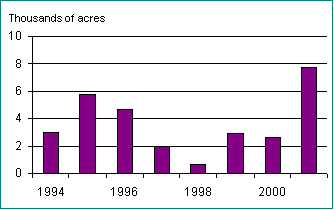
Acres infected with white pine blister rust, as detected during annual aerial surveys
This damage is of special concern since these alpine trees are very slow growing and important for wildlife. Additionally, a broad scattering of western white pine mortality was observed, but was not recorded during the survey because it did not meet the minimum threshold of groups of five trees or more.
Trends and Maps
Defoliation
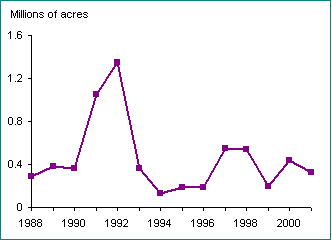
Annual acres defoliated as detected during aerial surveys
in Washington
Cumulative Defoliation in Washington
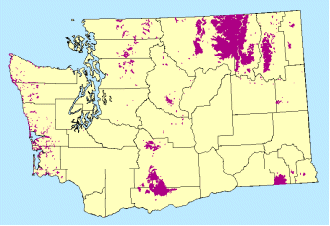
Cumulative defoliation for 1989-1993 (5 years)
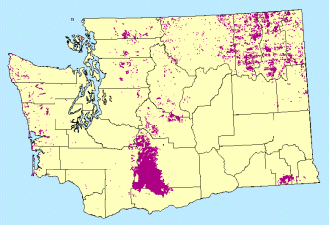
Cumulative defoliation for 1994-2001 (8 years)
Defoliation Frequency in Washington
click on a map below for larger, zoomable pdf versions
![]()
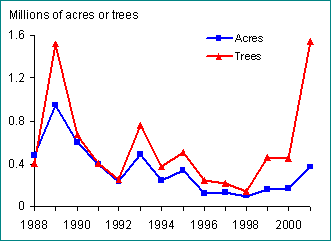
Annual acres with tree mortality and number of trees killed
as detected during aerial surveys in Washington
Cumulative Tree Mortality in Washington
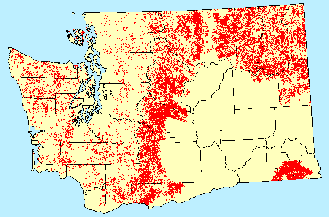
Cumulative mortality for 1989-1993 (5 years)
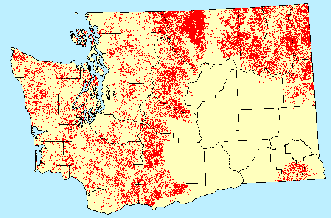
Cumulative mortality for 1994-2001 (8 years)
Tree Mortality Frequency in Washington
click on a map below for larger, zoomable pdf versions
Summary Tables for 2000 - 2001
| All Washington | A summary of all aerial survey observations in Washington for 2000 and
2001, sorted by land ownership category and causal agent. (a 97 KB pdf file) |
| Western Washington | A summary of all aerial survey observations in western Washington for
2000 and 2001, sorted by causal agent and land ownership category. This
table includes data from the following counties: Clallam, Clark, Cowlitz,
Grays Harbour, Island, Jefferson, King, Kitsap, Lewis, Mason, Pacific, Pierce,
San Juan, Skagit, Skamania, Snohomish, Thurston, Wahkiakum, and Whatcom.
(a 100 KB pdf file) |
| Eastern Washington | A summary of all aerial survey observations in eastern Washington for
2000 and 2001, sorted by causal agent and land ownership category. This
table includes data from the following counties: Asotin, Chelan, Columbia,
Douglas, Ferry, Garfield, Kittitas, Klickitat, Lincoln, Okanogan, Pend Oreille,
Spokane, Steven's, Walla Walla, Whitman, and Yakima. (a 104 KB pdf file) |
Contacts and Additional Information
If you have questions about forest insect and disease activity in Washington, please contact one of these regional or field offices:
State of Washington
Forest Health Program
Department of Natural Resources
P.O. Box 47037
Olympia, WA 98504-7037
(360) 902-1691 (Karen Ripley)
902-1692 (Dan Omdal)
902-1320 (Jeff Moore)
email: forest_health@wadnr.gov
Forest Service
Forest Health Monitoring Program
Mount Hood National Forest
16400 Champion Way
Sandy, OR 97055
(503) 668-1476 (Keith Sprengel),
email: ksprengel@fs.fed.us
website: http://www.fs.fed.us/pnw/fia/fhmpage/
Forest Insects & Diseases (Washington
and Oregon)
Pacific Northwest Region, Natural Resources
P.O. Box 3623
Portland, OR 97208-3623
(503) 808-2913 (Doug Daoust)
email: ddaoust@fs.fed.us
website: http://www.fs.fed.us/r6/nr/fid/
Wenatchee Service Center (northeastern &
north-central Washington)
Forestry Sciences Laboratory
1133 N. Western
Wenatchee, WA 98801
(509) 664-2777 (Jim Hadfield),
664-2749 (Paul
Flanagan),
664-2768 (Roy Magelssen)
jshadfield@fs.fed.us,
pflanagan@fs.fed.us, rmagelssen@fs.fed.us
Westside Service Center (western Oregon and
Washington)
Mount Hood National Forest
16400 Champion Way
Sandy, OR 97055
(503) 668-1474 (Diane Hildebrand),
668-1475 (Bruce
Hostetler),
668-1476 (Keith
Sprengel),
668-1477 (Beth
Willhite)
bhostetler@fs.fed.us, ksprengel@fs.fed.us,
bwillhite@fs.fed.us
go to a more printable PDF version of this
document

